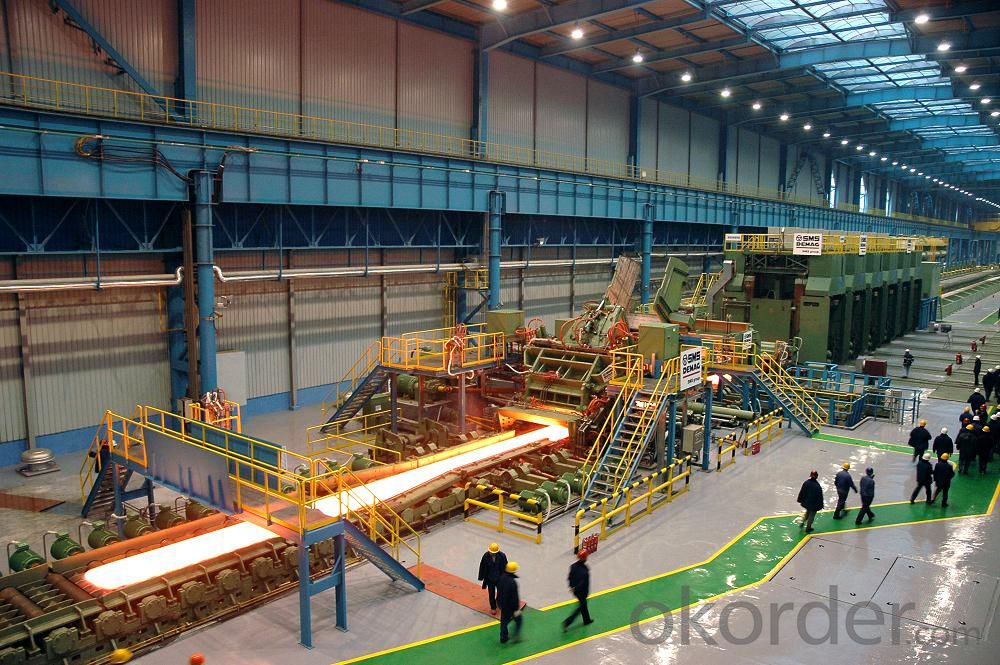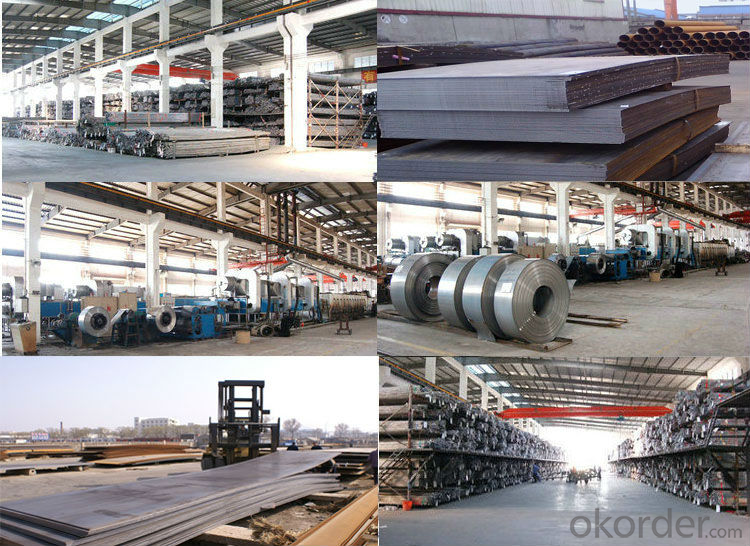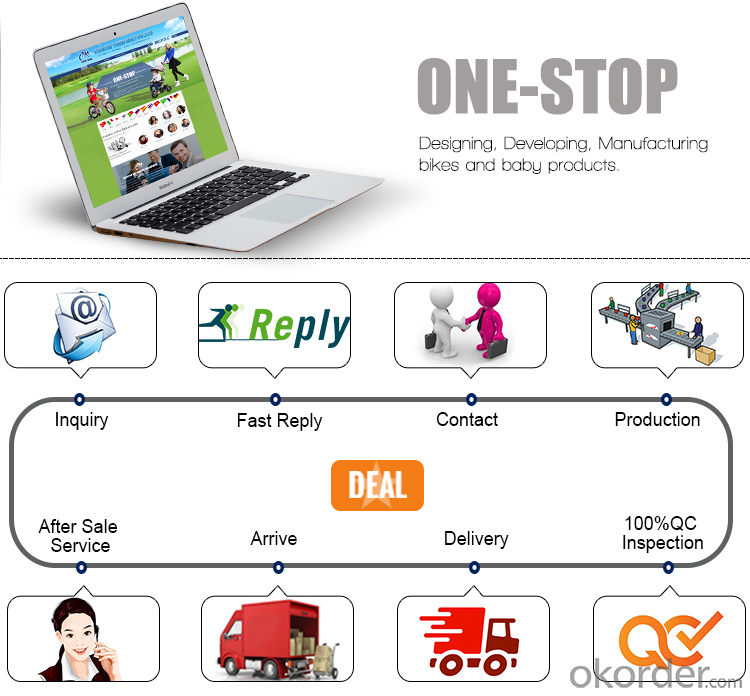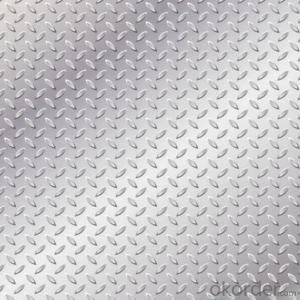Prime Hot Rolled Chequered Sheet Sheet China
- Loading Port:
- China main port
- Payment Terms:
- TT OR LC
- Min Order Qty:
- 23 m.t.
- Supply Capability:
- 10000 m.t./month
OKorder Service Pledge
OKorder Financial Service
You Might Also Like
Item specifice
Product Description:
1, carbon steel rimmed steel sheet (GB3274-88)
Steel rimmed steel sheet as the name suggests is made by boiling hot rolled steel plate made of ordinary carbon structural steel. Rimming steel deoxygenation is a complete steel, steel liquid oxygen content is higher, when molten steel after the injection mould, carbon oxygen reaction to produce large amounts of gas, resulting in liquid steel was named after boiling state. Rimming steel with low carbon content, and because no FeSi deoxidization, so steel containing silicon amount <0.07%. Boiling steel outer layer is crystallized in the boiling state, so the surface clean, compact, good surface quality, good processing performance. Rimming steel no large shrinkage hole, deoxidizer used less, low cost of steel. Rimming steel heart of impurities, with the serious segregation, mechanical heterogeneity, more gas in steel, low toughness, cold brittleness and aging sensitivity is larger, the welding performance is poor, so it does not apply to manufacturing under impact load, welding pieces of the structure and other important components work under low temperature.
Steel plate used in the manufacture of all kinds of stamping parts, construction and engineering structure and the structure of the machine is not too important and parts of boiling. The grade, chemical composition and mechanical properties of the material with GB700-79 (88) (technical specification for steel structure of ordinary carbon steel provisions boiling). Hot rolled thick steel plate with thickness of 4.5-200mm. Production units are mainly of Anshan Iron and steel company, Wuhan, Maanshan Iron and steel, TISCO, Chongqing steel, Handan iron and Steel General Factory, Xinyu steel, Liuzhou steel, Anyang steel company, Yingkou plate plant of Tianjin steel and etc..
2 killed steel, plain carbon steel (GB3274-88)
Ordinary carbon steel plate is made of ordinary carbon structural steel hot-rolled steel billet sedation. Deoxidation fully killed steel is steel, steel liquid deoxidation ferromanganese, ferrosilicon and full aluminum ingot casting liquid steel in front, more calm in the mould, does not produce the boiling state, so named for the killed steel. Advantages of killed steel is uniform chemical composition, so the mechanical properties of each part is uniform, the welding performance and good ductility, corrosion resistance is strong. But the surface of poor quality, concentrated shrinkage, higher cost.
Ordinary killed steel is mainly used for structural components, production impact at low temperature welding structure, and other requirements of high strength. The grade, chemical composition and mechanical properties of the material with GB700-79 (88) (technical conditions of steel carbon structure) provisions in killed steel. Size thickness of 4.5-200mm plate. Anshan Iron and steel company, Wuhan Iron and steel are the main production units, Wuyang Steel Corp, Maanshan Iron and steel, TISCO, Chongqing steel, Handan iron and Steel General Factory, Xinyu steel, Liuzhou steel, Anyang, Tianjin, Yingkou Steel Corp steel medium plate plant, a steel, three factory, Shaoguan iron and steel plant and Ji'nan iron and steel factory.
3, low alloy structural steel (GB3274-88)
Low alloy structural steel plate is made of hot rolled low alloy structural steel. Low alloy steel plate is killed steel and semi killed steel sheet. The utility model has the advantages of high strength, good performance, can save large amounts of steel, reduce the structure weight etc.. Low alloy structural steel is more and more widely used in machinery manufacturing and metal structural parts. Thickness of hot rolled steel plate 4.5-200mm. The production unit including Anshan, Wuhan, Wuyang Steel Corp, Maanshan Iron and steel, Chongqing steel, Xinyu steel, Liuzhou steel, Kunming Steel Corp, Tianjin steel, Shaoguan steel plant, Anyang Steel Corp, a steel, three factory and taiyuan.
Steel plate hot rolling with 4, general structure (GB2517-81)
Mainly used for general structure of buildings, bridges, vehicles, etc.. Steel plate (belt) thickness from 1.2-13.0mm; width from 700-1550mm; the length from 2000-12000mm.
5, welded weathering steel with structure (GB4172-84)
Weathering steel is atmospheric corrosion resistant steel. Welding structure with weathering steel is adding small amount of alloying elements in steel, such as steel, chromium, nickel, molybdenum, niobium, titanium, zirconium and vanadium, which form a protective layer on the surface of a metal matrix, in order to improve the weathering steel, and good welding performance. Mainly used in bridges, buildings and other structures.
6, high weatherability, structural steel plates (GB4171-84)
Atmospheric corrosion resistance of weathering steel is economic. Adding small amount of alloying elements in steel, such as steel, phosphorus, chromium, nickel, molybdenum and niobium, titanium, zirconium and vanadium, the level of protection to improve the weathering resistance steel is formed on the surface of the metal substrate. Mainly applicable to buildings, vehicles, towers and other structures.
7, checkered steel plate (GB3277-82)
Pattern plate is the surface with diamond or lentil shaped rib plate. The specifications to the thickness (rib thickness excluding) said. The pattern plate is provided with antiskid effect, often used as a floor, workshop, working frame escalator pedal, the deck of a ship and car plate etc.. The pattern plate material with ordinary carbon structural steel B1, B2 and B3 grade steel rolling form, its chemical composition meet the GB700-79 (technical conditions of steel carbon structure) regulations. Production units are mainly the Anshan Iron and steel and Anyang Steel Corp.
Steel plate for 8, bridge (YB168-70)
The bridge plate is dedicated to the rack railway or highway bridge plate making. Load and impact requirements and has high strength, toughness and bear the locomotive and vehicle, and have good fatigue resistance, low temperature toughness of certain and atmospheric corrosion resistance. Tethered to the welding of bridge steel also has good welding performance and low notch sensitivity. The main structural element for a railway bridge and highway bridge span between 46-160mm. The specifications: thickness from 6-50mm, width, length from 1.0-2.4mm from 2.0-16mm. The production of bridges in China are mainly used steel Anshan, Wuhan steel, steel unit three factory and Chongqing steel etc..
2.Product Images



3.Our Service
- Q:which one(glass or steel)has more power and velocity? im planning on using my slingshot for hunting.
- steel fo shizzle, glass can break, but steal goes threw. And wat are u hunting for dear? lol
- Q:How are steel coils used in the manufacturing of construction formwork?
- Steel coils are used in the manufacturing of construction formwork to create the framework and support structures needed for pouring concrete. The steel coils are typically shaped and cut into various sections to form the desired shape and size of the formwork. These coils provide strength, durability, and stability, ensuring that the formwork can withstand the weight and pressure of the concrete during the construction process.
- Q:were iron age weapons made of steel?
- Even in very early iron, a small amount of steel was produced by carburization, where the iron picks up carbon by laying in hot coals before quenching. This produces a thin layer of steel on the surface of the iron. By about 300 BC Damascus steel was being produced by the crucible method on the Indian subcontinent, and the Romans used steel from Noricum. In the first century BC the Chinese were melting cast iron and wrought iron together to make steel.
- Q:How are steel coils used in the production of steel wire?
- Steel coils are used in the production of steel wire by being uncoiled and fed into a wire drawing machine. The steel wire is then drawn through a series of dies to reduce its diameter and increase its length. The coils provide a continuous and consistent supply of steel, ensuring a smooth and efficient production process.
- Q:How do steel coils contribute to energy efficiency in transportation?
- There are several ways in which steel coils help improve energy efficiency in transportation. To begin with, steel coils are lightweight and have a high strength-to-weight ratio. This means that they require less steel material to carry the same load compared to other materials like wood or concrete. As a result, the overall weight of the transport vehicle is reduced, leading to lower fuel consumption and emissions. Furthermore, steel coils are extremely durable and can withstand harsh transportation conditions. They are highly resistant to corrosion, impact, and fatigue, ensuring a longer lifespan for the transport vehicle. This durability reduces the need for frequent repairs or replacements, resulting in reduced energy consumption and material waste. Moreover, steel coils are easily handled and transported. Due to their compact and standardized size, they can be effortlessly loaded and unloaded from trucks, trains, or ships. This efficiency in handling reduces the time and energy required for loading and unloading operations, ultimately increasing overall transportation efficiency. Additionally, steel coils can be efficiently stacked and stored, maximizing the utilization of available space in transport vehicles. This reduces the number of trips needed to transport the same amount of goods, resulting in less energy consumption and lower transportation costs. Lastly, steel is a highly recyclable material. At the end of their life cycle, steel coils can be easily recycled and used to produce new steel products. This reduces the demand for raw materials and the energy required for manufacturing new products, thereby contributing to overall energy efficiency in transportation. In conclusion, steel coils play a crucial role in enhancing energy efficiency in transportation. Their lightweight, durable, easy-to-handle, and recyclable nature leads to decreased fuel consumption, lower emissions, reduced maintenance needs, efficient use of space, and minimized material waste. All of these factors contribute to a more sustainable and energy-efficient transportation system.
- Q:What are the different types of surface defects in steel coils?
- Some common types of surface defects in steel coils include scratches, pits, rust, scaling, laminations, and waviness.
- Q:I feel really stupid asking this question but i feel like a put metal/steel strings on my classical guitar how do you tell the difference?
- Nylon strings are made of nylon; steel strings are made of .... if you put steel strings on your nylon string (classical style) guitar, you will destroy it. The instrument cannot stand up under the tension required for the strings, they will not fit in the saddle properly, they will cut the nut, and your machine heads may break. ... now if you're asking about the three lowest strings, those are metal wound around nylon on a nylon string guitar.
- Q:what is the difference between METAL and STEEL?
- Steel is a type of metal. There are many types of metals - some are simple elements such as copper, tin, iron or lead whilst others are mixtures of elements known as alloys such as bronze, brass... and steel. EDIT - and yes, once again Wikipedia has led someone astray. Metals are NOT exclusively elements. Metals are defined by their properties of being ductile, malleable and sonerous. Thus metals include both elements and alloys. Or is someone seriously proposing that a person building a steel structure such as a ship is not working in metal?
- Q:How are steel coils protected from corrosion?
- Steel coils are protected from corrosion through a variety of methods, including applying a protective coating such as zinc or polymer, using corrosion inhibitors, storing the coils in a controlled environment with proper ventilation and humidity control, and implementing regular inspection and maintenance practices to identify and address any potential corrosion issues promptly.
- Q:How are steel coils inspected for edge quality using visual inspection?
- To ensure that steel coils meet the necessary standards and specifications, visual inspection methods are employed to assess their edge quality. This involves carefully examining the edges of the coils to identify any defects or imperfections that may have occurred during manufacturing or handling. During this inspection process, trained inspectors visually assess the edges of the steel coils for various parameters, such as burrs, cracks, unevenness, roughness, and other irregularities that could impact the steel's quality and performance. To conduct these assessments, they utilize specialized tools like magnifying glasses, microscopes, or cameras to closely observe and analyze the edges. Each coil is meticulously inspected by the inspectors to detect any signs of defects that could potentially affect the steel's functionality or integrity. They pay meticulous attention to detail, ensuring that the edges are smooth, devoid of sharp edges or protrusions, and possess consistent dimensions throughout the coil. Apart from visual inspection, inspectors may also employ specific testing methods like dye penetrant testing or ultrasonic testing to further evaluate the quality of the steel coil edges. These supplementary tests aid in detecting any hidden defects that may not be visible to the naked eye. As a whole, visual inspection plays a vital role in the quality control process for steel coils by allowing for the identification and elimination of edge defects that could compromise the steel's performance and durability. By ensuring that the edges meet the required standards, visual inspection helps to uphold the quality and dependability of the steel coils.
1. Manufacturer Overview |
|
|---|---|
| Location | |
| Year Established | |
| Annual Output Value | |
| Main Markets | |
| Company Certifications | |
2. Manufacturer Certificates |
|
|---|---|
| a) Certification Name | |
| Range | |
| Reference | |
| Validity Period | |
3. Manufacturer Capability |
|
|---|---|
| a)Trade Capacity | |
| Nearest Port | |
| Export Percentage | |
| No.of Employees in Trade Department | |
| Language Spoken: | |
| b)Factory Information | |
| Factory Size: | |
| No. of Production Lines | |
| Contract Manufacturing | |
| Product Price Range | |
Send your message to us
Prime Hot Rolled Chequered Sheet Sheet China
- Loading Port:
- China main port
- Payment Terms:
- TT OR LC
- Min Order Qty:
- 23 m.t.
- Supply Capability:
- 10000 m.t./month
OKorder Service Pledge
OKorder Financial Service
Similar products
New products
Hot products
Related keywords




























